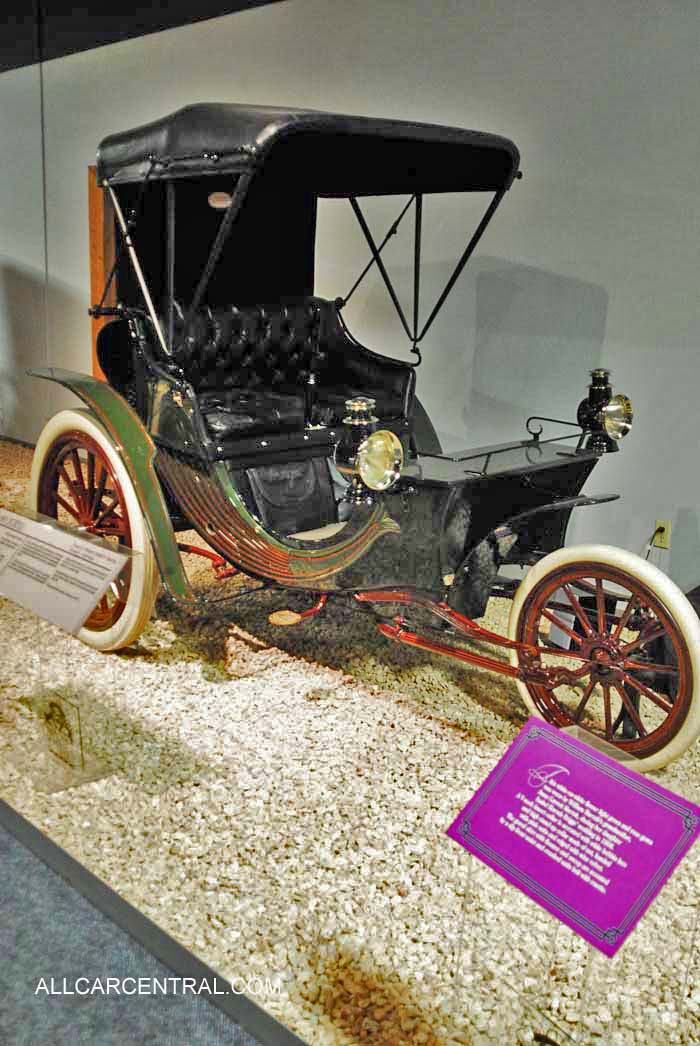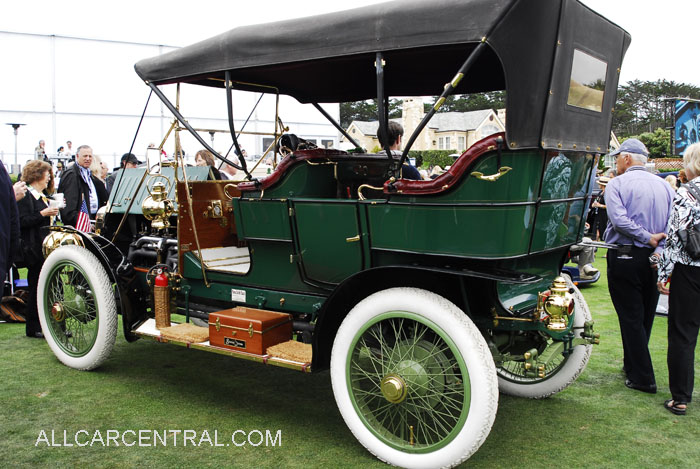Duryea 3 Wheeled Phaeton 1903... Descriptive Poster For This Car - JPG file
"One Hand Does It All" claimed Duryea of the steering mechanism of the 3 wheeled vehicle. Twisting the control handle activated the gear selector and throttle. Moving the tiller left or right controlled the direction.

In 1999 I was presented with the AACA Writer of the year award for a series that I did on the life of William Morris, the British motor tycoon who ended up one of the most wealthy and successful man in the world. It is not surprising to hear that he was also a close friend of Henry Ford. The award is named the Duryea Award after one of the earliest motor companies in the USA. I have never really researched the history of this company until few months ago when it accrued to me that as a recipient of the award I should at least have some idea and knowledge of "Duryea" and of course why the name should be considered important in the history of the automobile! In reality there were four companies with this name all the result of the engineering and design of two brothers, Frank and Charlie Duyea.
The first company was formed in 1895 and lasted for the next three years however a separate company was formed around the same time that was producing cars from 1899 through to 1913. Located in Pen State and Saginaw, Mich. In 1892 they built a motor car that in reality was a motor buggy.
However it ran and it was reported that the vehicle achieved a speed of eight miles an hour with a Four H.P engine. A second car was produced a few months later and was entered and won America's first motor race from Chicago to Evanston on Thanksgiving Day 1895 covering the distance of fifty miles in nine hours. (Put your calculus away the average was just over five miles an hour but remember the car had to stay on the dirt roads and get up the various hills etc on the journey.
The brothers also were the first company to be formed in America to design and produce gasoline powered vehicles. There had been various small operations producing electric c vehicles but as always the problem was charging the batteries every few hours. However in London England a large Department store with a very strong American background used electric vehicles to deliver purchases and set up a series of charging points around the West end where many of their customers lived.
This was certainly helped by the fact that London had installed an electric subway system in the 1870's that could supply electricity for the vehicles. By 1916 Duryea was in full production including a three wheel vehicle with a front wheel drive, called the Duryea Gem. The success of the company can be measured by the fact that they opened a production plant in Coventry England and also granted license rights to a manufacturer in Belgium. The principle driving force and design brother was Charles. Frank simply kept the books so to speak! The demise of the general market in 1918 when the First World War ended forced many vehicle manufactures into bankruptcy and Duryea was no exception. In reality they still saw the market as a motorized buggy with a tiller rather than a steering wheel also they were dependent on outside manufacturers for engines so when many of them went under so did the supply system for such companies as Duryea.
Stevens-Duryea AA Torpedo Five Passenger 1911

Henry Ford was inspired by Duryea and called it a "masterpiece" and crediting the brothers with starting the automotive industry.
Frank left the Duryea Motor Wagon Company in 1899 and two years later he helped start the Stevens-Duryea Company, with Frank Stevens in Chicopee Falls, Massachusetts
making the Stevens-Duryea automobile. The first car was a 2-cylinder runabout. They sold cars under Stevens-Duryea name until 1915 when they sold to new owners.
Ed.
Manufacturers such as Ford did not have such problems they made their own engines and even sold to other manufactures. The economic depression at the end of Post War was the result of anticipation, by that I mean the Allies believed that the war would end in 1919 which in reality it did but by the fall of 1918 Germany was on its knees with its allies in much the same condition. An armistice was negotiated and fighting ceased in November 1918. (The real peace treaty was signed a year later). Half of the industrial wealth of the allies had been dedicated to the war effort with production slated to continue well into 1919. This of course stopped with the armistice and companies were left with goods that were no longer required. Example, the Ford Company had over 1500 war vehicles waiting to be shipped to Europe.
The same situation applied to Britain especially the Morris Company who was the largest manufacturer in Europe at that time. Ford bit the bullet and disposed of his stock sending two hundred at his own cost to the White Russians fighting the Bolsheviks. Morris simply sold off whatever he could at cost or less.
Of course this simply added to the weak economy and certainly affected the sales of other vehicle manufacturers many whom simply went to the wall carrying debt. As indicated Duryea was one of many. There has been some discussion about who was first to produce a fuel powered vehicle in America but Duryea seems to be the eventual choice. We know there were various steam powered vehicles that claim to be the first but in reality Duryea put the first on the market when they sold the second car produced to a willing customer after it had won the American Race.
Geoff Wheatley

BACK TO TOP